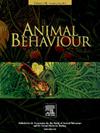On the function of the male’s front legs in Sepsis flies (Diptera: Sepsidae): evolutionary insight from behavioural detail
IF 2.3
2区 生物学
Q2 BEHAVIORAL SCIENCES
引用次数: 0
Abstract
Male genitalia and nongenital structures that contact the female during copulation diverge rapidly. Two hypotheses propose different explanations for this rapid divergence: sexual conflict and female choice. The sexual conflict hypothesis posits that differential reproductive optima of the two sexes lead to sexually antagonistic coevolution. The female choice hypothesis posits that female preferences drive rapid divergence in male courtship structures. We tested these hypotheses with sepsid flies, which have been considered case studies of sexual conflict involving males using their species-specific front legs to hold the females' wings and females resisting this hold. In terms of these flies, the sexual conflict hypothesis predicts that the male front legs function as mechanical devices to clamp the female wings. The female choice hypothesis predicts that the male front legs function as stimulatory courtship devices. We tested these predictions by carefully observing mating interactions and morphological contact in two closely related species, Sepsis fulgens and Sepsis violacea. We found that males use their front legs to perform rhythmic, stereotypic and species-specific tactile stimulation on the female wing zones that contained numerous campaniform sense organs and sensory setae. We conclude that male front legs are stimulation devices rather than species-specific mechanical clamps. These results support the female choice hypothesis and emphasize the power of attention to behavioural detail to promote discovery.
求助全文
约1分钟内获得全文
求助全文
来源期刊

Animal Behaviour
生物-动物学
CiteScore
4.60
自引率
8.00%
发文量
236
审稿时长
10.2 weeks
期刊介绍:
Growing interest in behavioural biology and the international reputation of Animal Behaviour prompted an expansion to monthly publication in 1989. Animal Behaviour continues to be the journal of choice for biologists, ethologists, psychologists, physiologists, and veterinarians with an interest in the subject.
 求助内容:
求助内容: 应助结果提醒方式:
应助结果提醒方式:


